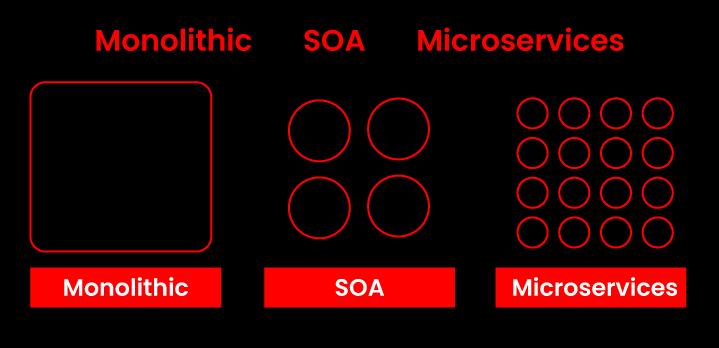- Home
- Blog
- Microservices
- Microservices vs SOA - What's the Difference?

In this article, we would be explaining the basics of Microservices vs SOA, how both are different from each other, and which approach would be better for your business requirements.
At very first glance, two approaches may sound so similar. But if you examine them closely, you can find out the important differences they have. Before jumping directly into the differences, it would be better to know the basics of them. So, let's start with SOA.
SOA vs Microservices - What is the difference?
- Microservices vs SOA: Architecture
- Microservices vs SOA: Component Sharing
- Microservices vs SOA: Granularity
- Microservices vs SOA: Data Storage
- Microservices vs SOA: Size and scope
- Microservices vs SOA: Communication
- Microservices vs SOA: Coupling and Cohesion
- Microservices vs SOA: Remote Services
- Microservices vs SOA: Deployment
So, let us begin with the SOA definition first, which I am going to talk about in the section below.
If you want to enrich your career and become a professional in Microservices, then visit Mindmajix - a global online training platform: "Microservices Online Course". This course will help you to achieve excellence in this domain.
What is SOA (Service-Oriented Architecture)?
SOA breaks up the whole application into separate service modules that interact with one another to carry out the specific business objectives. In SOA, every module is considerably smaller in size when compared with a monolithic application.
Additionally, it is delivered via the cloud and offers services for applications, infrastructure, and platforms.
SOA offers four different types of services:
- Functional services: for business operations
- Enterprise services: to implement the functionality
- Application services: to develop and deploy apps
- Infrastructure services: non-functional processes including security and authentication
SOA makes use of an enterprise service bus (ESB) which helps in coordinating and controlling these services.
What is Microservices Architecture?
Microservice architecture can be considered as an evolution of SOA due to its more granular nature and functioning independently.
The services in microservices communicate with each other through API (Application Programming Interface) and combine with each other to build a complex application.
Since every single service is independent, microservice applications are more fault-tolerant than applications developed using other approaches. Microservices are deployed in the cloud and in many instances, they operate in containers.
[ Related Article: What are Microservices ]
Microservices Vs SOA - Major Differences between Microservices and SOA
Both SOA and Microservices have similarities and differences as well. But here, we would be focusing on the difference between microservices and SOA.
They function in cloud settings and thus each can scale to fulfill the requirements of big data size and speed.
|
Microservices
|
SOA
| |
|
Architecture
|
Designed to host services that can function independently
|
Designed to share resources across services
|
|
Granularity
|
Fine-grained services
|
Comparatively larger and modular services
|
|
Data Storage
|
Each service has an independent database
|
Services share data more frequently
|
|
Component Sharing
|
No component sharing
|
Supports frequent component sharing
|
|
Deployment
|
Quick and easy deployment
|
Comparatively less flexibility in deployment
|
|
Coupling & Cohesion
|
Relies on the bounded context for coupling
|
Relies on sharing resources
|
|
Communication
|
Communicates through an API layer
|
Communicates through an ESB
|
|
Size and Scope
|
Best for a smaller and web-based application
|
Preferred for large scale integrations
|
|
Uses REST and JMS
|
Uses protocols like SOAP and AMQP
|
Let's see the Key Differences Between Microservices & SOA in detail:
#1. Microservices vs SOA: Architecture
In Microservices architecture, the software is a collection of several small services that perform a single function independently.
Therefore, we can say that there is the least sharing of resources between the services. But in SOA, services are larger and share resources as much as possible with each other.
Microservices Architecture Tutorial
#2. Microservices vs SOA: Component Sharing
As microservices are independent of each other, they hardly need to share components which makes the services resistant to failure.
Moreover, the lack of component sharing allows developers to deploy the latest versions, and scale individual services much faster as compared to SOA.
In SOA, sharing components is very common. Thus, an issue in one service may affect the effectiveness of the other connected services
[ Related Article: Microservices Interview Questions & Answers ]
#3. Microservices vs SOA: Granularity
In SOA, services are large and modular resembling monolithic applications. As each service is capable of scale, SOAs have a broad range of focus.
In microservices, services are of more granular nature which means individual services excel in carrying out a single specific task. However, combining all those tasks results in a single application.
#4. Microservices vs SOA: Data Storage
In a microservices architecture, each individual service has its own data storage. Whereas in the SOA approach, groups of services share the same database to store the data. The biggest advantage of sharing the same database enables SOA services to reuse the shared data amongst services.
#5. Microservices vs SOA: Size and Scope
In the microservices approach, services are created to perform a single specific task and thus the size is smaller and the scope is very limited. In other words, we can say that services are customized for that particular application and can't be reused.
Whereas, the larger size and scope of SOA allows integrations of diverse services. It connects services for cross-enterprise collaboration and thus we can say the scope is wide or vast as compared to microservices.
#6. Microservices vs SOA: Communication
SOA communication is handled by an ESB (Enterprise Service Bus). It acts as a medium for services to talk or interact with each other. On the other hand, Microservices rely on simple messaging systems for communication.
#7. Microservices vs SOA: Coupling and Cohesion
Microservices works on the concept of "bounded context" and SOA is based on sharing components. Do you know what bounded context means? It is the coupling of components and their data with the least number of dependencies or we can say hardly any sharing is needed. This type of coupling leads to high cohesion which means a particular service can be easily isolated from the rest part in case it fails working.
SOA focuses on sharing which makes the processing slow and also prone to failure. Here, the coupling is least cohesive, and therefore an issue in one service causes other service failures.
#8. Microservices vs SOA: Remote Services
Both SOA and microservices use different protocols to access remote services. The primary remote access protocols used by SOA are - Simple Object Access Protocol (SOAP) and Microsoft Messaging Queuing (MSMQ), and Advanced Messaging Queuing Protocol (AMQP).
Some of the common protocols used in microservices include Representational State Transfers (REST) and simple messaging such as Java Messaging Service (JMS). The protocols used in microservices are more homogenous as compared to those for SOA, which are quite used for heterogeneous interoperability.
#9. Microservices vs SOA: Deployment
Now, ease of deployment is another point that will help us in differentiating these two architectures. As you all know very clearly that in Microservices, all the services are independent which is why they are easily and quickly deployed. SOA deployments are more complicated since services are coupled together.
SOA Vs Microservices - Which approach is better for your business?
Both the SOA Vs Microservices architectures have their own pros and cons, so how can you determine which approach suits your business better? In general, this decision can be taken on the basis of how large and diverse your application environment is.
If you have a requirement for a larger and diverse application environment, then opting for SOA would be a better choice to go with.
Smaller environments that include web and mobile applications do not need any robust communication and therefore are easier to develop using a microservices architecture.
With this, we would like to conclude the article and hope that you must have clearly understood the difference between microservices and SOA.
 On-Job Support Service
On-Job Support Service
Online Work Support for your on-job roles.

Our work-support plans provide precise options as per your project tasks. Whether you are a newbie or an experienced professional seeking assistance in completing project tasks, we are here with the following plans to meet your custom needs:
- Pay Per Hour
- Pay Per Week
- Monthly
| Name | Dates | |
|---|---|---|
| Microservices Training | Jan 13 to Jan 28 | View Details |
| Microservices Training | Jan 17 to Feb 01 | View Details |
| Microservices Training | Jan 20 to Feb 04 | View Details |
| Microservices Training | Jan 24 to Feb 08 | View Details |

Pooja Mishra is an enthusiastic content writer working at Mindmajix.com. She writes articles on the trending IT-related topics, including Big Data, Business Intelligence, Cloud computing, AI & Machine learning, and so on. Her way of writing is easy to understand and informative at the same time. You can reach her on LinkedIn & Twitter.
















